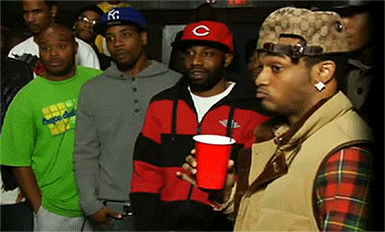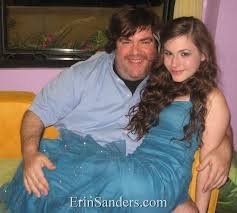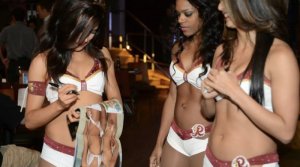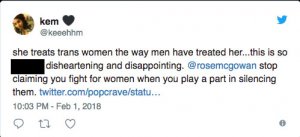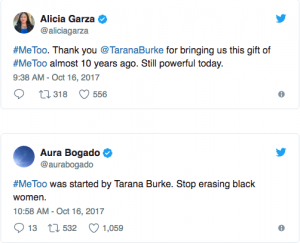Several N.F.L. teams determined cheerleading programs had a scarcity problem on game days. If cheerleaders were on the sideline dancing, none were available to serve as scantily clad hostesses who could mingle with fans high up in the cheap seats or in the luxury suites, where teams catered to big-money customers.
To address that shortcoming, some teams created a different kind of cheerleading team — one whose members did not do any cheering or require any dance training. They were hired mainly for their appearance. Their visits with male fans, the teams believed, produced a better game-day experience, akin to the approach of the Hooters restaurant chain.
In interviews with a dozen women who have worked for N.F.L. teams as noncheering cheerleaders and six others who had direct knowledge of the noncheering squads, they described minimum-wage jobs in which harassment and groping were common, particularly because the women were required to be on the front lines of partying fans. The fans had no reason to believe these women were not actual cheerleaders because the women often dressed exactly like the cheerleaders dancing on the field or nearly the same.
“It’s a really big secret, and now you know about it,” said Jackie Chambers, 33, a model with more than a decade of experience who worked as a Houston Texans noncheering cheerleader last season. “But teams don’t want fans to know about it. All of the cheerleaders are supposed to blend in with each other.”
The Texans, the New England Patriots, the New Orleans Saints and the Washington ******** are among the N.F.L. teams that use or have used an alternate roster of so-called cheerleaders whose primary task is to charm spectators at the game.
The Patriots have auditions for cheerleader promotional models, but after the cheerleading roster is set, the women — dancers and models — are grouped together. The team features both its models and its cheerleaders in its annual cheerleaders calendar.
The Ravens don’t hide the existence of a team of women — called the Playmakers — who might look and dress like cheerleaders but are actually marketers. An application for this season’s Playmakers asked for body measurements including bust size.
The ******** use their cheerleader ambassadors — their name for noncheering cheerleaders — in their promotional material for luxury suite sales. Their suites, like others in the N.F.L., provide a huge chunk of guaranteed revenue for the team, as each suite could cost hundreds of thousands of dollars per season. In the ********’ online sales video for these suites, they feature photos of suite owners posing with the team’s cheerleader ambassadors. Having close interaction with the ambassadors is a tacit perk of the elite club. As a voice-over in the video says, “membership has its privileges,” the video pans over a photo of a woman in a bikini.
The treatment of N.F.L. cheerleaders has attracted national attention recently. Several former cheerleaders have filed legal complaints — included one former Texans cheerleader on May 21 — and dozens of others in interviews with The New York Times described a hostile work environment in which they were used as sex symbols for male fans. Many of them said they remained committed to the job because they enjoyed the one activity they signed up for: cheerleading at games.
Many of the same grievances are held by the women on the alternate squads that do not cheer. Most of the women on these separate teams of models spoke on condition of anonymity because they had signed confidentiality agreements with the teams.
Bruce Allen, the ********’ president, said the team was continuing the investigation announced earlier this month of accusations related to the cheerleading program and would “take all appropriate action” upon its completion. “We are committed to ensuring that all ******** employees, including our cheerleaders and ambassadors, are treated with the upmost respect,” he said in a statement provided by the team’s spokesman, Maury Lane.
The concept of women-as-accessories to men’s sporting events has begun to fade. The Formula One auto racing circuit announced in January that it would stop using “grid girls,” the models in revealing outfits who roam the race’s starting area. They have been a staple of the sport for decades, but the “custom does not resonate with our brand values and clearly is at odds with modern day societal norms,” Sean Bratches, a Formula One managing director, said.
Some of the most prestigious professional cycling races have stopped using “podium girls,” who kiss the riders’ cheeks in the awards area and hand out prizes. The Vuelta a España ended the tradition last year and the Tour of California did so this year. Tour of California officials said the decision was made to “do the right thing.” The Tour de France said it might also no longer use podium girls.

But the N.F.L. has veered in the opposite direction, led by the ********, who were among the pioneers of using attractive women to ostensibly work as cheerleaders but, as one former ambassador put, actually serve as “eye candy” for male fans.
Around the early-to-mid 2000s, the ******** began hiring women as ambassadors from the group of women who didn’t make the cheerleading squad, and they still do today. The tryouts haven’t changed much, if at all. In an extra judging session, those women were required, like pageant contestants, to walk in bikinis in front of suite holders and sponsors who held score sheets. They also had to answer several questions that showed that, as the ********’ website stated, they had “great public relations skills.”
“The ******** wanted to come up with extra ways to make money, so they dreamed up the idea of the ambassadors,” said one woman who was one. “We were made to look almost exactly like cheerleaders, but we weren’t a member of that society. We didn’t get the perks of dancing. We were just low-paid, underappreciated, exploited moneymakers in a huge moneymaking scheme.”
She added: “We wore low-cut tops with cutouts and your butt cheeks would be sticking out the back. That’s how they sell the suites.”
The ambassadors were an inexpensive way to monetize the cheerleader concept. They weren’t invited on the annual calendar shoot held on an exotic beach. They didn’t require hours of practice to perfect their routines or multiple uniforms for game-day dances. While the cheerleaders’ white boots had rhinestone-encrusted heels, the ambassadors had to buy the rhinestones and glue them on to their own boots during a night billed as “team bonding.”
In interviews with six former ******** ambassadors, the women described the job as being more of a sexualized saleswoman than a cheerleader.
Instead of preparing for work in the locker room with cheerleaders, the ambassadors were relegated to the shower area opposite a row of toilet stalls.
“You thought it was going to be so glamorous and glitzy, like what the Cowboys’ cheerleaders have, but then you realized that they wanted to put you in your place as an ambassador,” said one former ambassador.
Another former ambassador said she dreaded working at team-sponsored tailgate parties, where fans were invited to chug beer. Intoxicated men would grab them and hug them, she said, and make inappropriate comments.
It was like, oh, yuck,” the former ambassador said, explaining that when asked to sign autographs she would write “Meg” next to her picture on the team photo. Her name is not Meg.
“I didn’t want to take the extra time to sign my real name,” said the woman, whose real name has two syllables. “I was just like, God, can we just get this over with?”
One of the worst parts of the day was the morning inspection.
Dennis Greene was head of business operations for the ******** from 2007 until several weeks ago, when he was replaced by a new hire, but he is still in charge of hospitality and suites. He is ultimately in charge of the ambassador program, and his job is to sell suites and keep the suite-holders happy. He would have the ambassadors line up so he could examine them and choose two to accompany him to suites during the game.
“He would look each of us up and down and say, I want that one and that one, and everyone hated when you got selected for that,” a former ambassador said of the lineups that occurred just a few years ago. “It was humiliating, like we were cattle.”
The ******** sold the ambassador role to women who weren’t chosen for the cheerleading squad by saying it was a way to prepare for the next year’s auditions and to get in the good graces of the team director, Stephanie Jojokian.
 As a noncheering cheerleader for the Texans last season, Jackie Chambers was generally on the field only for player introductions and the national anthem. CreditKen Murray/Icon Sportswire, via Getty Images
As a noncheering cheerleader for the Texans last season, Jackie Chambers was generally on the field only for player introductions and the national anthem. CreditKen Murray/Icon Sportswire, via Getty Images
Several former ambassadors said the ******** would “strongly encourage” the women to take classes at Capitol Movement, Jojokian’s nonprofit dance company, donate to the organization and attend its fund-raisers. They were steered to the hair salon and tanning salon that sponsored the team, so they could get the exact look of the cheerleaders, and often received a discount for those services.
One of the former ambassadors said: “It was like, if you want to make the cheerleading team, you’d better do all this stuff, and that included going to parties where there was a lot of drinking and there were definitely underage ambassadors. It might not be the best experience for the ladies, but you just shut up and do it because you want to be a cheerleader.”
Chambers, the former Texans cheerleader, was hired as an appearance team cheerleader, and the mention of “appearance-only cheerleader” was written into the team’s contract. She had no formal training as a dancer, but said she gave it a try as “a face of the team” because she was eager to interact with the community, especially with charities.
The Texans required their cheerleaders to work 50 promotional appearances each year, with the team earning tens of thousands of dollars for them, per cheerleader, while the women earned $7.25 an hour. Chambers hoped that many of those events would entail meeting children or visiting the military, and those appearances became “one of the few highlights” of her season.
Once inside the organization, Chambers said, she became dismayed by what she saw. She said the team’s coach, Alto Gary, verbally and emotionally abused the cheerleaders, and three of her teammates have confirmed that Gary treated the women poorly. It was unheard-of to say anything back to Gary, though, because “arguing or showing disrespect” to the coach was forbidden, according to their contract.
Last week, one of Chambers’s teammates
filed a lawsuit over pay and abuse, and Chambers intends to join the suit as a plaintiff if the case is certified as a class-action lawsuit.
In a statement, the Texans said: “We are proud of the cheerleader program and have had hundreds of women participate and enjoy their experience while making a positive impact in the local community. We are constantly evaluating our procedures and will continue to make adjustments as needed to make the program enjoyable for everyone.”
Before one game, Chambers and two of her teammates said, Gary taped a cheerleader’s stomach with thick tape to make it appear flatter under her shorts.
“That was a memory that was so vivid, I’ll never forget it,” Chambers said. “I can’t believe that it was even happening, but the girl did as she was told. It was exactly like a master controlling a puppet.”
The appearance team cheerleaders would be on the field for player introductions or special events like giveaway contests, but once the game began, they would head into the crowd and into the suites. In the suites, women would “get touched a lot because the men are intoxicated and think they can try anything,” she said.
She often would go into the stands to give fans prizes, like coupons for free furniture or tacos for a year. On one occasion, a fan ran his hands over her crotch. She notified a police officer and told the team, she said, but nothing was done about it.
At the team’s year-end meeting last month, Chambers said the women were given Starbucks gift cards in appreciation for their hard work. When Chambers tried to use the card, though, the cashier handed it back to her.
“Sorry, this card was never even registered,” the cashier said. “It’s a zero balance.”
When Chambers checked with her teammates, some said their cards had $5 on them.
“All of us said, wow, the Texans must have really appreciated us,” Chambers said. “We were laughing, but crying.”






